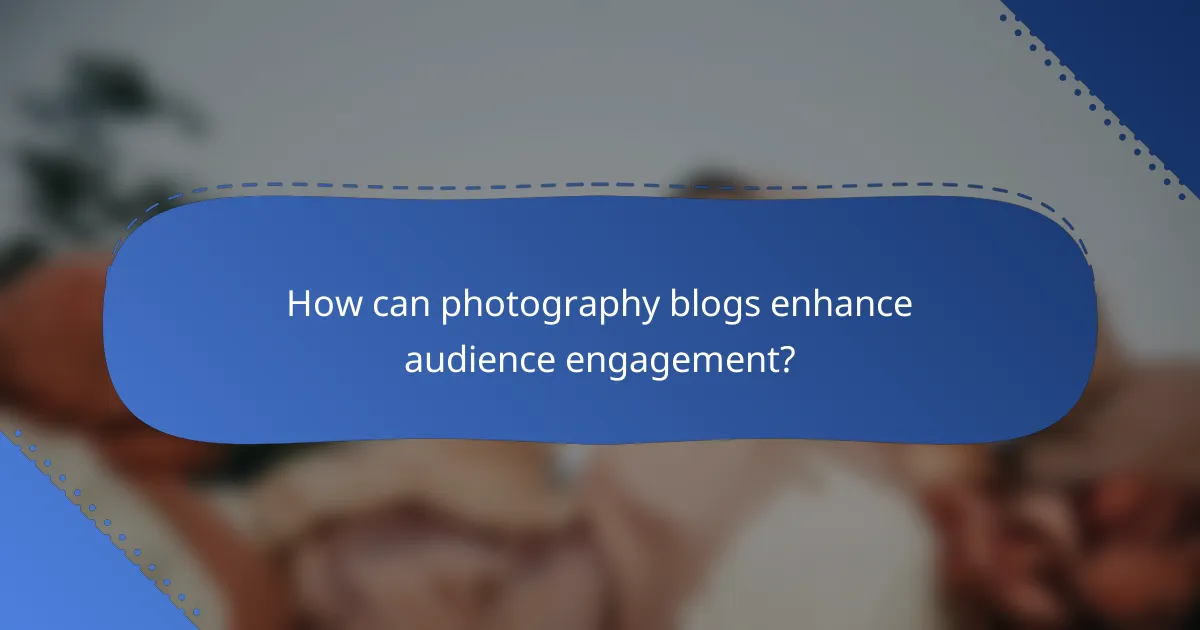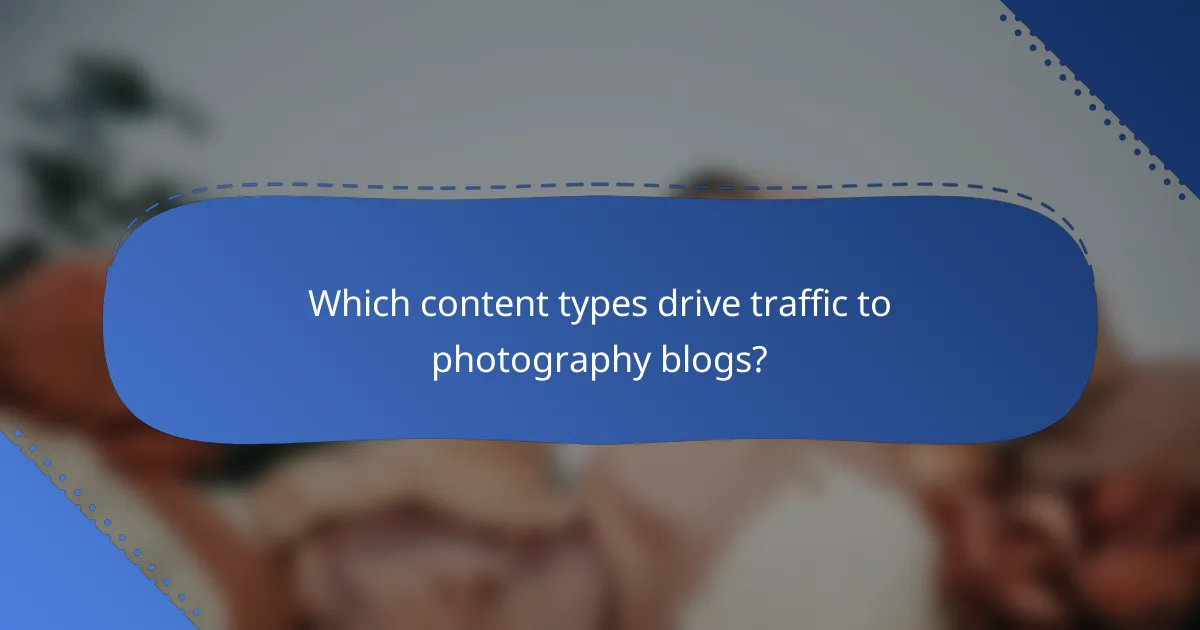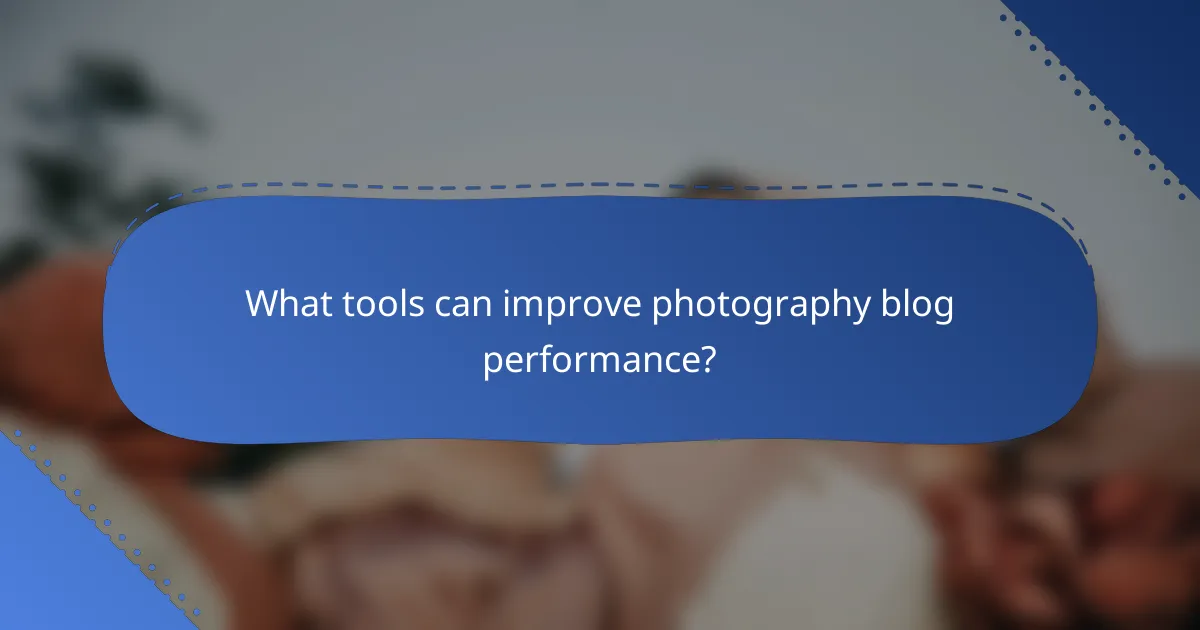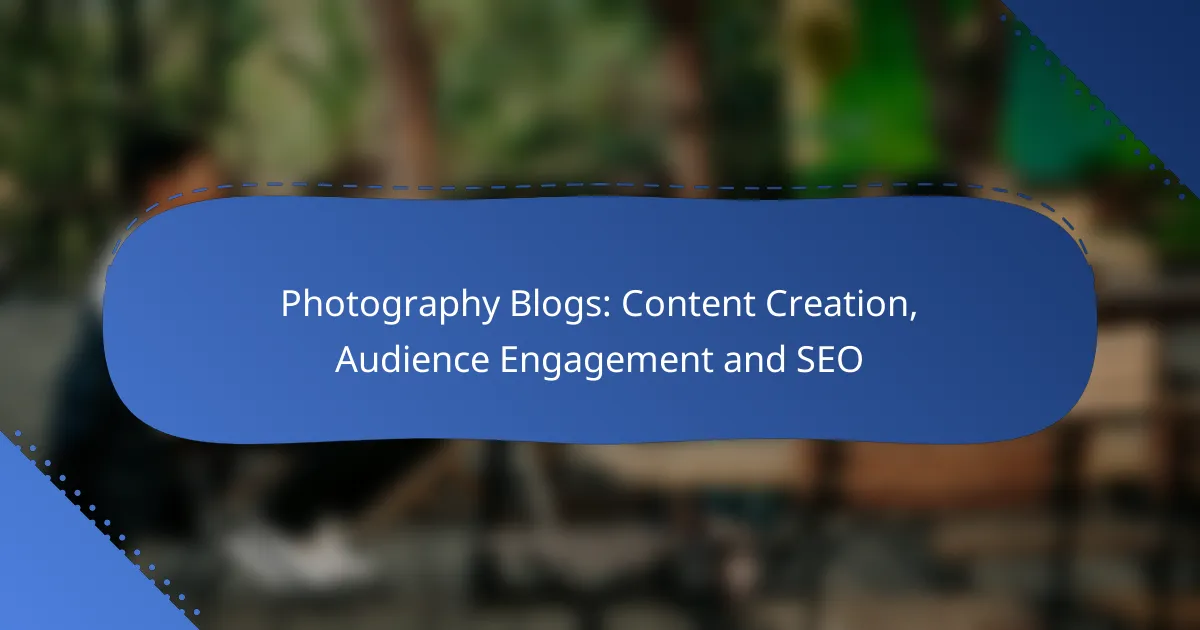Photography blogs serve as powerful platforms for enhancing audience engagement through interactive and community-driven experiences. By employing effective content strategies and SEO techniques, bloggers can optimize their visibility and foster deeper connections with their readers. Diverse content types, such as tutorials and photo essays, not only attract traffic but also cater to the varied interests of the photography community.

How can photography blogs enhance audience engagement?
Photography blogs can significantly enhance audience engagement by creating interactive and community-driven experiences. By leveraging various strategies, bloggers can foster deeper connections with their audience and encourage active participation.
Utilizing social media platforms
Social media platforms are essential for boosting audience engagement on photography blogs. Sharing blog content on platforms like Instagram, Facebook, and Pinterest allows photographers to reach a wider audience and attract potential followers. Engaging with users through comments and shares can create a sense of community and encourage more interaction.
Consider using visually appealing images and behind-the-scenes content to draw attention. Regularly posting updates and engaging with followers can help maintain interest and foster loyalty.
Incorporating interactive content
Interactive content, such as polls, quizzes, and surveys, can significantly enhance audience engagement on photography blogs. This type of content encourages readers to participate actively rather than passively consuming information. For example, a quiz about photography techniques can both educate and entertain your audience.
Additionally, consider using sliders to showcase before-and-after images or interactive galleries that allow users to explore different aspects of your work. This not only keeps readers engaged but also encourages them to spend more time on your site.
Building a community through comments
Encouraging comments on blog posts is a powerful way to build a community around your photography blog. Responding to comments fosters a sense of belonging and shows readers that their opinions are valued. Consider posing questions at the end of your posts to invite discussion.
Moderating comments to maintain a positive environment is crucial. Create guidelines for respectful interaction and be proactive in addressing any negative behavior to ensure a welcoming space for all readers.
Hosting photography contests
Hosting photography contests can be an effective strategy to engage your audience and encourage participation. Contests can motivate readers to submit their work, share your blog, and invite friends to join in. Offering prizes, such as photography gear or feature spots on your blog, can increase interest.
Promote the contest across your social media channels and provide clear guidelines for participation. This not only boosts engagement but also generates user-generated content that can be showcased on your blog.
Offering exclusive content
Providing exclusive content can entice readers to engage more deeply with your photography blog. Consider creating downloadable resources, such as eBooks or presets, that are only available to subscribers. This can encourage sign-ups and foster a loyal audience base.
Additionally, offering behind-the-scenes content or early access to new projects can make your audience feel special and valued. Regularly updating exclusive content keeps readers coming back for more and enhances their overall experience.

What are effective SEO strategies for photography blogs?
Effective SEO strategies for photography blogs focus on optimizing content, images, and backlinks to improve visibility in search engines. Implementing these strategies can significantly enhance audience engagement and drive more traffic to your site.
Keyword optimization techniques
Keyword optimization involves researching and integrating relevant keywords into your blog content to improve search engine rankings. Use tools like Google Keyword Planner or SEMrush to identify popular search terms related to photography.
Incorporate these keywords naturally into your titles, headings, and body text. Aim for a keyword density of around 1-2% to avoid keyword stuffing, which can negatively impact your SEO.
Image alt text best practices
Image alt text is essential for SEO as it helps search engines understand the content of your images. Always describe the image accurately and include relevant keywords when appropriate, but keep it concise—typically under 125 characters.
For example, instead of “photo123.jpg,” use “sunset-over-ocean-photography” as the file name and include a descriptive alt text like “A vibrant sunset over the ocean with waves crashing on the shore.” This practice not only improves SEO but also enhances accessibility for visually impaired users.
Creating quality backlinks
Quality backlinks from reputable sites can significantly boost your photography blog’s authority and search ranking. Focus on building relationships with other bloggers, photographers, and industry influencers to encourage them to link to your content.
Consider guest posting on related blogs or participating in photography forums to share your expertise. Aim for a diverse backlink profile, including links from social media, photography directories, and local business listings.
Utilizing local SEO tactics
Local SEO tactics are crucial for photography blogs targeting specific geographic areas. Optimize your blog for local searches by including location-based keywords in your content and metadata.
Claim your Google My Business listing and ensure your contact information is consistent across all platforms. Engage with local photography communities and consider collaborating with local businesses to enhance your online presence.

Which content types drive traffic to photography blogs?
Content types that effectively drive traffic to photography blogs include tutorials, photo essays, equipment reviews, and interviews. Each of these formats engages readers in different ways, catering to their interests and enhancing the overall user experience.
Tutorials and how-to guides
Tutorials and how-to guides are among the most sought-after content types on photography blogs. They provide practical advice and step-by-step instructions, helping readers improve their skills or learn new techniques.
When creating tutorials, consider breaking down complex topics into manageable sections. Use clear language and include visuals to illustrate key points. For example, a guide on portrait photography might cover lighting setups, camera settings, and posing tips.
Photo essays and storytelling
Photo essays and storytelling capture the audience’s imagination by combining compelling visuals with narrative. This format allows photographers to share their experiences and perspectives, creating an emotional connection with readers.
To craft an engaging photo essay, choose a theme that resonates with your audience. Use a mix of images and text to convey your message, ensuring that each photo contributes to the overall story. For instance, a photo essay on urban life could showcase diverse neighborhoods and their unique characteristics.
Equipment reviews and comparisons
Equipment reviews and comparisons help readers make informed purchasing decisions by providing insights into various photography gear. These articles can cover cameras, lenses, accessories, and software, highlighting pros and cons for each item.
When writing reviews, focus on real-world performance and usability. Include specifications, price ranges, and user experiences to give a comprehensive overview. A comparison table can be useful for contrasting features of similar products, such as two popular camera models.
Interviews with photographers
Interviews with photographers offer valuable insights into the creative process and industry trends. They allow readers to learn from experienced professionals, gaining inspiration and practical tips.
To conduct effective interviews, prepare thoughtful questions that encourage detailed responses. Highlight the interviewee’s background, techniques, and personal stories. Sharing these conversations can foster a sense of community and encourage engagement among readers who share similar interests.

What tools can improve photography blog performance?
Several tools can significantly enhance the performance of a photography blog by improving tracking, optimization, and design. Utilizing these tools effectively can lead to better audience engagement and higher search engine visibility.
Google Analytics for tracking
Google Analytics is essential for tracking visitor behavior on your photography blog. It provides insights into how users interact with your content, including page views, session duration, and bounce rates.
To get started, set up an account and integrate the tracking code into your blog. Regularly review the data to identify popular posts and understand audience demographics, which can inform your content strategy.
Yoast SEO for optimization
Yoast SEO is a powerful plugin that helps optimize your photography blog for search engines. It offers real-time analysis of your content, suggesting improvements for keywords, readability, and meta descriptions.
When using Yoast, focus on the green indicators for SEO and readability scores. Aim for a keyword density of around 1-2% and ensure your images have alt text to improve visibility in search results.
Canva for graphic design
Canva is a user-friendly graphic design tool that can elevate the visual appeal of your photography blog. It offers templates for social media posts, blog headers, and infographics, making it easy to create professional-looking graphics.
Utilize Canva’s drag-and-drop features to customize designs quickly. Keep your branding consistent by using similar colors and fonts across all graphics, which helps in building a recognizable identity for your blog.
